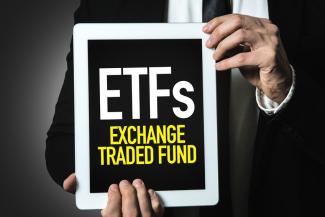
Understanding Exchange-Traded Funds
If you’d like to take advantage of the ease of stock trading with the diversification of mutual funds, exchange-traded funds (ETFs) could give you an attractive alternative option. Here are some key things to know about ETFs before investing.
ETF Basics
Exchange-traded funds are baskets of securities—stocks, bonds, commodities or a combination of the three. The fund provider owns a group of assets and creates a fund to track the group’s performance. They then sell shares of that fund to investors. Some well-known ETFs include SPDR S&P 500 (SPY), which tracks the S&P 500 Index, and SPDR Gold Shares (GLD), which tracks physically-backed gold securities.
ETFs vs. Mutual Funds
One of the advantages of investing in an ETF is the diversification of funds without having to invest in each asset individually. In this respect, ETFs are similar to mutual funds, with a few key exceptions.
First, ETFs are traded on an exchange throughout the day, much like stocks. Mutual funds, on the other hand, are traded just once per day after the markets close. The price of an ETF could change throughout the day, but a mutual fund’s price will update daily.
There may also be lower cost and more tax-efficiency advantages to investing in an ETF versus a mutual fund. For the most part, ETFs are tracked passively, which means management and operational costs are generally low. And compared to mutual funds, there is less turnover for ETFs. Less buying and selling of assets may result in fewer capital gains and greater tax-efficiency. Additionally, investors in ETFs are only taxed upon selling their investment, whereas mutual fund investors incur a tax burden over the course of their investment.
Lastly, ETFs have greater transparency than mutual funds. Anyone can access the price activity for an ETF, and the fund’s holdings are disclosed each day to the public.
Potential Downfalls of ETFs
Although ETFs offer many benefits, there are some things to consider before investing. If you’re comparing the price of an ETF to investing in individual stocks, you may find that prices are higher because of broker commissions and management expenses.
In general, the risks of investing in an ETF is lower because it’s a diversified basket, but this could also mean that dividend yields are lower. More risk can come with more rewards, so if you’re looking for a higher payoff, you may want to invest in individual stocks instead of ETFs.
You should also be sure to research the type of ETF that you’re investing in. Actively-managed ETFs, while uncommon, will typically have higher fees associated with them. If you’re investing in a single industry-focused ETF, it could also hinder the amount of diversification that you’re looking for, especially compared to investments in individual stocks and other assets. As with any investment, it’s a good idea to talk to a financial professional before committing funds to make sure you are on the right track to meeting your financial goals.
This content is developed from sources believed to be providing accurate information. Neither the information presented nor any opinion expressed constitutes a representation by us of a specific investment or the purchase or sale of any securities. Asset allocation and diversification do not ensure a profit or protect against loss in declining markets. This material was developed and produced by Advisor Websites to provide information on a topic that may be of interest. Copyright 2025 Advisor Websites. This material has been prepared by a third party that is unaffiliated with Townsend Asset Management Corp. and is provided for informational purposes only. It may not represent the views of Townsend or its affiliates. Townsend has obtained permission to distribute this material. Townsend Asset Management Corp. is an independent investment adviser registered under the Investment Advisers Act of 1940, as amended. Registration does not imply a certain level of skill or training. More information about the firm can be found in its Form ADV Part 2, which is available upon request. TAM-20-77.

